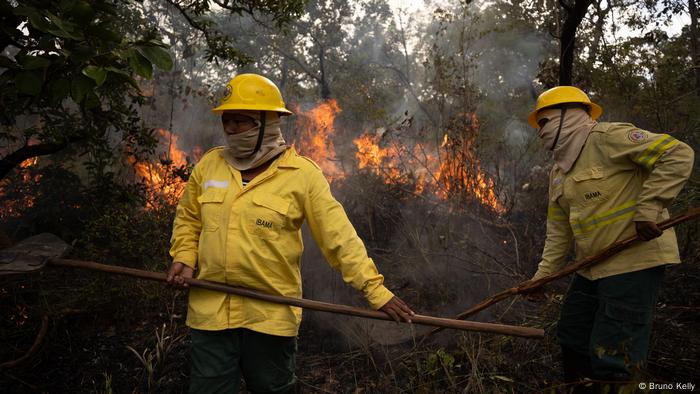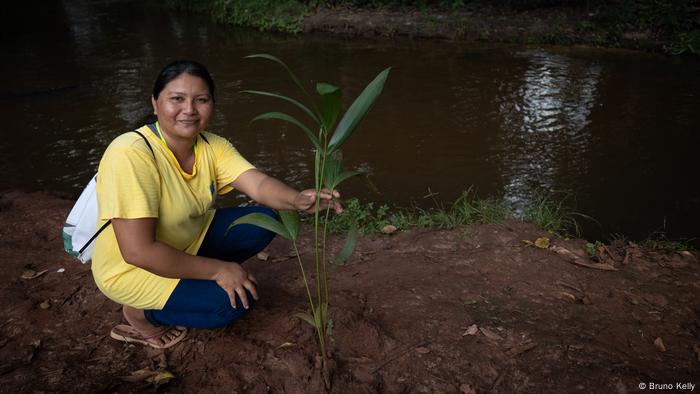The Apinajé People's Volunteer Brigade is the first in the region to be made up entirely of women. With the support of the Brazilian Environmental Institute, she fights for the preservation of the rainforest.

Firefighter Salma Apinajé: “I want to show that we women are strong too”
Marlucia Apinajé stands in front of her team and gives the command to count. After everyone in the line says their number out loud, they repeat in a firm voice, “We're 29.”
The 29 indigenous women in fireproof clothing belong to the first female brigade of the volunteer fire brigade in the Amazon. They are from the Apinajé people in the north of the Brazilian state of Tocantins. This is her first assignment a few months after completing her training at the Brazilian Environmental Protection Agency (IBAMA).
Every May since 2014, a brigade has been taking care of so-called “queimas prescritas” (prescribed fires). Preventive fires are set and monitored at strategic points. This method is intended to prevent the spread of wildfires in the Amazon rainforest during the dry season from August to October.
Maria Aparecida Apinajé, known to everyone as Cida, is one of the initiators of the women's fire brigade team. “Our project is about preserving our traditions, raising environmental awareness and warning about the dangers of forest fires and the destruction of our lands,” she explains.
But some of the 43 graduates of the fire brigade training had to face difficulties even before the course started. “My husband was against it, he even wanted to break up with me,” says Kelly Apinajé. “He thinks women should stay home and take care of the kids.”
His threats didn't stop the young woman. She left her village and left her husband to take care of their four children for two days.

Fire on Extinguishing in full gear and at over 30 degrees is hard physical work
Controlled fires to avoid large fires
When the “queimas prescritas” begin on a hot May afternoon, the thermometer shows 31 degrees. Experienced firefighters guide the women in alternating groups to set fires in strategic locations – and then control them.
“We get exhausted quickly because we have to carry heavy things and it's extremely hot,” says Salma Apinajé. Putting out forest fires together with men is a completely new experience for her and the other women. “I came forward to show that we women are strong and capable of things like this, not just men,” she says.
The designation of the 1420 square kilometer protected area began in 1980 and was completed in 1997. The lengthy process was overshadowed by violent conflicts. The indigenous reserve is surrounded by farms and is intersected at one point by the Transamazônica highway. Antonio Apinajé, the leader of the people, says: “We fought until they gave us a piece of land, which according to Brazilian law is also ours.”

Aerial view of the Apinajé Reserve and adjacent pastures in the Brazilian state of Tocantins
According to the firefighters, many forest fires here are started by people who come to the indigenous area from outside. “There are a lot of fishermen and hunters who invade here,” says Robson Apinajé, head of the reserve's prevention unit. “And when the farms around the sanctuary burn down pastures, the fire spreads to our area.”
More fires
According to data from the National Institute for Space Research (INPE), the number of fires in the indigenous areas has risen again after hitting a decade-low in 2018. The INPE has been monitoring using satellite imagery since the 1970s the state of Brazilian forests.
As with many here, the damage caused by fires in the past – on the forest, on the fruit trees, the wild animals, the medicinal herbs – is all too present for Marlucia Apinajé. In the nearby village of Prata, she runs a nursery for the reforestation of degraded areas. “I want to plant some springs that are already drying up. I'm fighting to ensure that we don't lose our plants, our medicinal herbs, that we don't let everything die out,” she says, pointing to various seedlings growing in the shade of a stream .

Marlucia Apinajé shows nursery plants to be used for reforestation
Preserving nature for future generations
Suene Apinajé has also joined the voluntary fire brigade women. She hopes to join the contract brigade in the future. There, the mother of four would receive minimum wage for six months of work, which would give her family a higher income.
Robson Apinajé gets emotional when he talks about the efforts that the indigenous women are making. “It's not easy for a woman to leave home. The Apinajé women are role models, they are warriors,” he says.
Kelly Apinajé, one of the most talkative of the group, is exhausted after bringing the fire under control. “I won't give up. I can't do much, but at least something – together with these women who give me strength,” she says out of breath.
But the work in the volunteer brigade is not supposed to remain the only initiative. In addition to many other tasks, co-initiator Cida also strives for further external support for environmental education and women's promotion measures in the villages. “We are looking for improvements for our future, for our children. Our ancestors fought for us to have a protected area, now we have to take good care of it for future generations. This is our heritage”, she says.
Adaptation: Ines Eisele
*This feature was produced with support from the Dom Phillips Fellowship, a special grant from the Pulitzer Center Rainforest Journalism Fund.
< h2>Brazil: Can the Amazon rainforest still be saved?